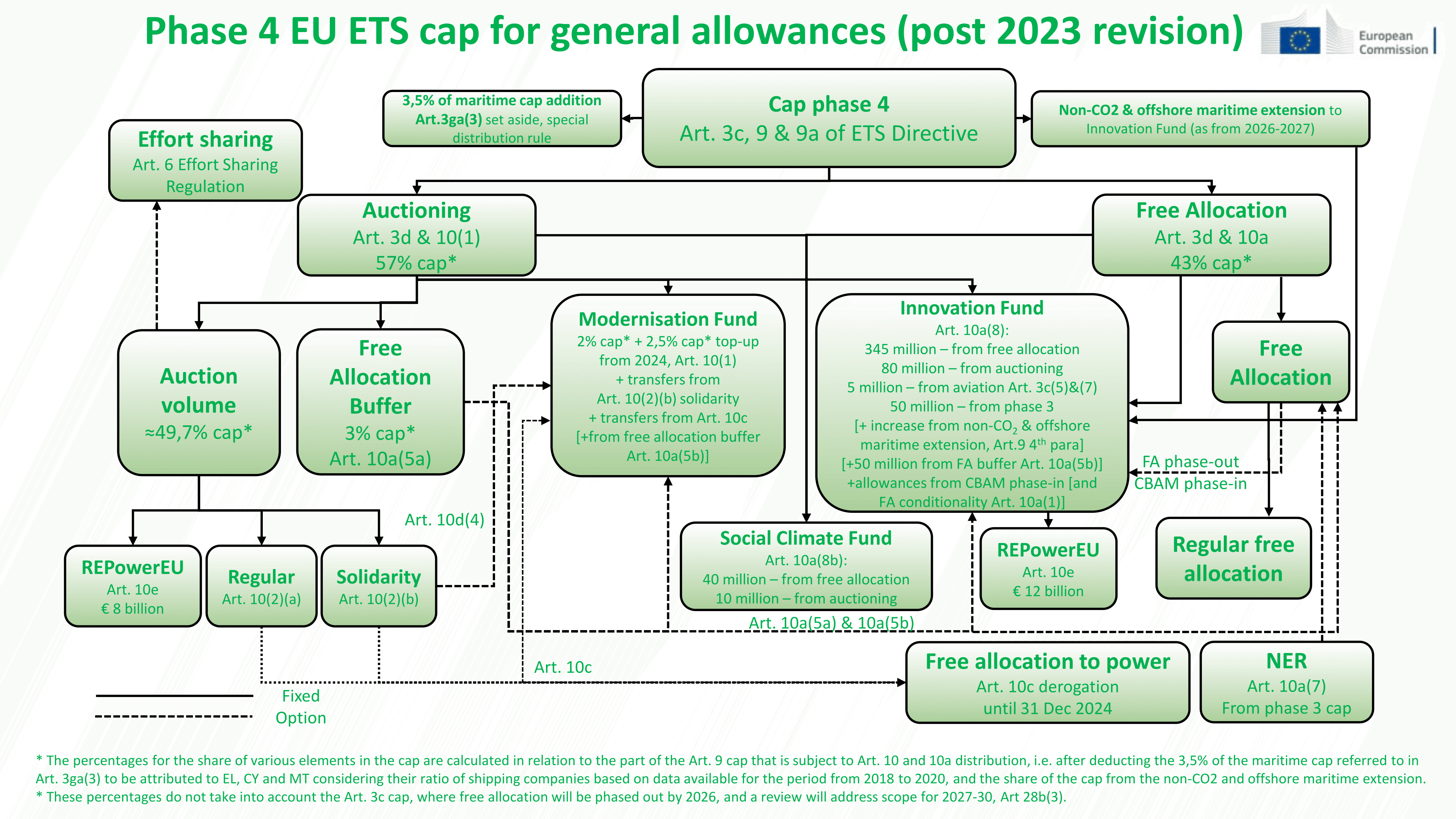Explore the basics of the EU ETS
About the EU ETS emissions cap
The EU ETS covers greenhouse gas (GHG) emissions from installations and operators in the following sectors across the EU:
- electricity and heat generation
- industrial manufacturing
- aviation (since 2012) and maritime transport (since 2024)
The system applies in all EU Member States, Iceland, Liechtenstein and Norway, as well as Northern Ireland for electricity generation (under the Protocol of Ireland and Northern Ireland).
The overall volume of greenhouse gases that can be emitted by installations and operators in the EU ETS is limited by a cap. This limit corresponds to the number of emission allowances issued over a certain period under the system.
Each allowance gives the right to emit one tonne of CO2eq (carbon dioxide equivalent).
Separate cap calculations apply to emissions from electricity and heat generation, industry and maritime transport and from aircraft operators, as explained below.
Electricity and heat generation, industrial manufacturing and maritime transport
Since 2013, there has been an EU-wide cap on emissions from power plants and industry installations.
The cap is reduced annually in line with the EU’s climate target, with a yearly reduction factor determining the pace of reduction.
The reduction factor is applied to the reference cap value, namely the average total volume of allowances issued annually under the system over the 2008-2012 period.
A reduction factor of 1.74% per year applied until 2020. Starting in 2021, the factor increased to 2.2% per year.
Following the 2023 revision of the ETS Directive, the EU ETS cap is set to bring emissions down by 62% by 2030 compared to 2005 levels. To achieve this, the reduction factor has been increased to 4.3% per year over the period 2024-2027 and to 4.4% per year from 2028.
Two cap reductions (rebasing) have also been scheduled before 2030 – by 90 million allowances in 2024 and by 27 million allowances in 2026.
At the same time, emissions from maritime transport have been brought under the scope of the EU ETS from 2024. To account for this, the cap was increased by 78.4 million allowances. This increase was based on the maritime sector’s average emissions reported for 2018 and 2019.
These adjustments have been addressed in Commission Decision of 27 July 2023. The Commission informed that the EU ETS cap for 2024 amounts to 1,386,051,745 allowances.
Within the cap, allowances are primarily auctioned by Member States, while some are allocated for free to industry sectors with the aim of addressing the risk of carbon leakage.
Starting in 2021 (and ending in 2030), portions of the cap have been set aside:
- to ensure that a sufficient volume of allowances is available for free allocation (‘free allocation buffer’)
- to be monetised for the Innovation Fund, Modernisation Fund and the Social Climate Fund
In addition, a reserve of allowances from the cap of the previous phase (2013-2020) is available for new entrants to the EU ETS.
For more information on the breakdown of the EU ETS cap after 2023, see a dedicated diagram located in the Documentation section below.
Aviation
The EU ETS sets a cap on emissions from aircraft operators flying within the European Economic Area and departing to Switzerland and the United Kingdom.
The aviation cap is calculated bottom-up:
- Allowances allocated for free represent 82% of the aviation cap
- 3% of the aviation cap is set aside for the special reserve of new entrants
- 15% of the aviation cap is auctioned
Since 2021, the aviation cap is also subject to the yearly reduction factor mentioned above.
Since 2024, the share of the aviation cap that is auctioned gradually increases. As a result, free allocation for aircraft operators will be phased out from 2026. Over the 2024-2030 period, 20 million allowances from the aviation cap are reserved to support the uptake of alternative fuels.
Documentation
Cap diagram (post-2023)

Cap decisions
- 27/07/2023 - Commission Decision (EU) 2023/1575 of 27 July 2023 on the Union-wide quantity of allowances to be issued under the EU Emissions Trading System for 2024
- 16/11/2020 - Commission Decision (EU) 2020/1722 on the Union-wide quantity of allowances to be issued under the EU Emissions Trading System for 2021
